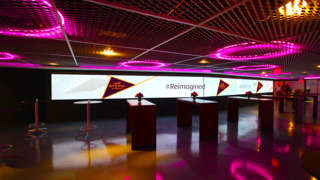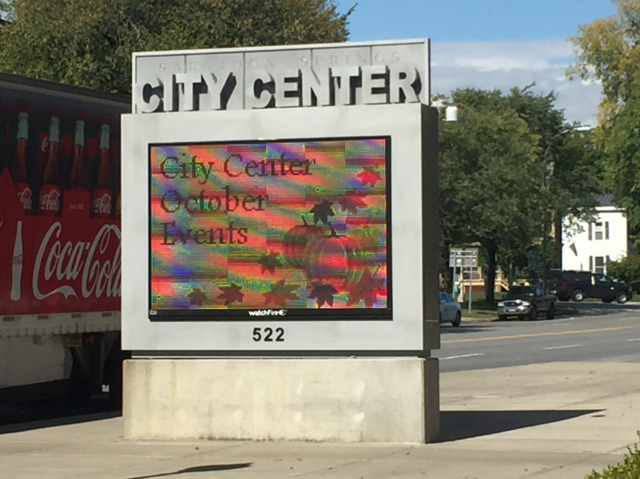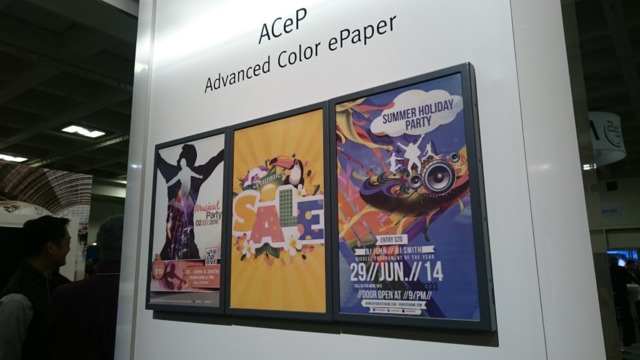Smart Signs
Dynamic digital signage moves in unusual directions.

Several years ago, tout le monde was talking about dynamic digital signage (DDS), and while the hubbub and hullaballoo have died down a bit, DDS has been quietly expanding.
“From our standpoint, the demand for it has done nothing but increase, at least in our world,” said Wayne Rasor, director of digital and exterior technology for FASTSIGNS International, Inc. “The technology continues to get cheaper and easier, so there are people still trying to do it themselves, saying, 'OK, I can get a TV for this and I can sign up for this service and I can try and do it.' But with DDS, the hardware is the easiest and cheapest—but least important—part of the equation. I think they miss the content piece of it, and that’s always been our focus.”
Content in the context of dynamic digital signage has also been evolving, and the emphasis now is less on a static menu board or even piping in a deck of PowerPoint slides, and more on integration with external databases and content that is, well, dynamic.
“I would rather do a menu board up on a screen that’s connected to a database that I can change from anywhere in the world, and my screens change and update in real time with either availability of items on the menu or pricing changes based on demand, promotions in the area, that kind of thing,” Rasor said.
The hardware has of course been getting cheaper, but in some cases has been switching from LCD-based screens to LED displays, although not necessarily in single-screen displays, but in “tiled” video walls.
“We’re seeing much, much fewer multi-screen LCD video walls and more large, fine-pitch LED video walls. A single, 55-inch display still is probably better just to go with an LCD screen,” Rasor said.
But, like anything with technology, they will only get better and cheaper, and it’s not hard to envision a time when LED-based DDS displays take over, even for single screens.
“Eventually, those LCD screens will most likely just go away,” he said. “It may take four or five more years, maybe 10 years, but they’re eventually going to go as the LEDs continue to get cheaper and cheaper.”
 Smaller pixel pitches (aka higher resolution) making LED signage increasingly suitable for indoor displays. (Image courtesy SNA Displays.)
Smaller pixel pitches (aka higher resolution) making LED signage increasingly suitable for indoor displays. (Image courtesy SNA Displays.)
DDS is not just LCD (or even LED) indoor displays. Outdoor electronic message centers (EMCs) are a growth area in the world of DDS, but are not without controversy.
“We get calls for outside message centers and we’ve done a few of those,” said Rick Bult, owner of FASTSIGNS of Saratoga Springs (N.Y.). “That can be a little hit and miss depending on the town you’re working with. There are a lot of local codes, and Saratoga doesn’t allow them at all.”
Go one town south, though, and the situation changes.
“If you go down to Malta [N.Y.], they just last year adopted digital signage in their code. They’re still very strict on size, height and how the content is displayed. That is sort of typical, and you’ll see them dictate how often the message can change.”
The concern with outdoor message centers is driver distraction, so the sign codes pertaining to EMCs often specify things like message transitions.
“Can it just go slide-left, slide-right? Can you do an explosion? Can you have really crazy 3D effects? No, you can’t do that,” Bult said. “How often can you to change the message? They don’t want things changing every three seconds. They're very careful about what they consider to be distracting to a driver.”
 Electronic Message Centers (EMC) are becoming popular among churches, schools, convention centers, and other venues—but are not loved by those who draft municipal sign codes.
Electronic Message Centers (EMC) are becoming popular among churches, schools, convention centers, and other venues—but are not loved by those who draft municipal sign codes.
Dayparts is Dayparts
Dynamic digital signage is also more than a big LED or LED display on a wall, and there are all sorts of things you can do, even with technologies that may not seem like dynamic digital signage.
“You’ve got to look beyond just that one little small television and realize that the print industry is definitely not left behind,” said Vantage LED’s Deacon Wardlow, an author, speaker and expert on digital signage.
Wardlow is conducting an educational session called “5 Simple Steps to Successful Sales with Digital Signage” at April’s ISA Sign Expo.
“You can even look at E Ink. They’ve got the ACeP—the Advanced Color ePaper—which is capable of displaying millions of colors, and it uses less power than a AA battery for most of the screens," he said. "So you can have smart posters that are print material reflective and using low energy that are completely programmable.”
There are also materials on the market that can automatically change their daytime and nighttime operations displaying different images or graphics depending on how it’s illuminated. If it receives reflected light—such as from the sun in daytime—or if it receives rear-projected light such as at night, the sign could change accordingly.
“You could totally change the name of the business,” Wardlow said. “When you’ve got businesses in New York, where square footage is really high, you may have a location that doesn’t operate 24/7 but now can. So maybe during the morning, it’s operated by one owner/operator who runs it as a diner for breakfast or lunch and then the evening shift comes in, they change the décor, and they make it into a nighttime restaurant from 4 until midnight. The sign actually changes the name of the establishment, and there are no digital elements outside of the printing.”
 E Ink’s Advanced Color ePaper (ACeP)— a color version of the e-paper technology used in the Amazon Kindle and other ebook readers—can be used to create smart posters and other kinds of dynamic digital signage without using LCD or LED displays. (Image courtesy Good E Reader)
E Ink’s Advanced Color ePaper (ACeP)— a color version of the e-paper technology used in the Amazon Kindle and other ebook readers—can be used to create smart posters and other kinds of dynamic digital signage without using LCD or LED displays. (Image courtesy Good E Reader)
From the Big Screen to the Small Screen
When people in the sign business—or even in the printing business looking to get into the sign business—look at dynamic digital signage (if they look at it at all), they focus on the screen and, if they’re lucky, the content. But DDS is evolving in ways that may not even involve “the sign” at all. And a “dynamic digital sign” could in fact be a user’s own mobile device—which for some sign companies is the Holy Grail of signage.
“That’s the screen everybody wants to get to,” Rasor said. “When you’re talking about interaction and advertising in the digital out-of-home space, the screen up on the wall is valuable, but doesn’t even hold a candle to that screen in your pocket.”
The technology to bridge the gap between display signage and mobile devices is still a work in progress, but it’s getting there, and it’s one of the ways that signage is becoming “smart.”
It sounds like this would be intrusive—who wants random signs sending notifications to their phone?—but it could be a highly desirable feature, kind of a proactive Yelp!.
"I'm kind of a nerd, and I travel a lot, so if there’s a comic book shop or a scifi place or game shop or a cool museum, I want to know about it," Wardlow said. "So I can set my device to say, 'When there’s a point of interest that’s in these 10 categories, let me know.’ So next time I’m walking around Seattle, it’ll say, ‘Hey, within two blocks is the Seattle Pinball Museum. Would you like to go?” All right, yeah, I’ve got 20–30 minutes, and it’ll walk me to it.”
We’re getting a little far afield of signage—or are we?
“I think the signs are going to be integrated to that degree as well,” Wardlow said, “maybe to the point where some sign shops will need to start looking at programming these kinds of things so that they’re no longer just selling a sign package for the front of your business.”
The idea is that, when someone walks past the sign, it sends a push notification to the individual’s phone—“Hey, we’ve got a special today, are you interested?” There could even be a coupon or other kind of offer.
Funny, I was writing about this basic idea in the early 2000s when mobile phones were first taking off, and the idea was that a Border’s Book Store—this is how long ago it was—would ring the mobile of a passerby with some kind of offer. We may be more receptive to this kind of notification today than we were literally a generation ago. And it is certainly easier to deploy today than it was 20 years ago.
“Sign makers are going start integrating high-tech into their low-tech—a blade sign will now have a bunch of stuff in it that looks like a normal blade sign, but has a ton of tech behind it,” Wardlow said.
Smart Signs, Foolish Choices
“A lot of people ask, ‘what’s the future of signage?’” Wardlow said. “When you think ‘future’ you think scifi movies where it’s all digital LED or projection signage, and that’s really limiting your scope on what the future of signage is. You could have a smart sign that technically has no digital elements to it other than the print form.”
Smart signage—and as Wardlow pointed out above, it doesn’t necessarily have to be a digital display—is signage that in some ways does the opposite of what DDS does. Instead of displaying data from a database like DDS applications do, it collects data.
“You could, say, take an internally illuminated cabinet or a set of channel letters that’s in a downtown market like here in Denver,” Wardlow said. “You’ve got a blade sign that has a nice print on it. You can add Bluetooth low-energy and Near Field Communication devices to track and push advertising and information to people on their mobile phones.”
In other words, a “static” sign broadcasts its messaging to make the user’s phone becomes the dynamic digital signage. This is nothing truly new, even if it is not very widely deployed (yet).
But wait, there’s more.
“You could then take the next step,” Wardlow said, “and put cameras on your sign for security, but those cameras can also link to tracking software that identifies the traffic that goes into your business or organization. So if you do have a digital component to your display, whether it’s LCD or LED, then you can actually track how many people responded to the sign. The tracking system can even tell you how many of those people were looking at the sign and then chose to come in. So you could actually track traffic based on your marketing and look at your marketing responses based on that eye tracking.”
The smart sign can also break down the demographics of that traffic—gender, age, ethnicity, etc.
This is facial detection technology and, again, is nothing new from a technological standpoint, but has yet to be deployed in a major fashion—and it’s not hard to see why, as privacy issues are starting to take center stage. And sometimes the developers creating these capabilities need to be schooled on how they describe these systems.
“We’ve actually had to correct several different software companies that use the term ‘facial recognition,’” Rasor said. “No, you have facial detection. There’s a difference. Detection is, ‘I detected a face and that face is a male or it’s a female, and we think it’s about this age, and it was in this mood’ and those kinds of things. That’s it. Facial recognition is what the government or the NSA does. That means, ‘I know who you are, I see your face, and I identify you with this identity.’ We’ve told these software companies, ‘you don’t want to be in that business. You don't want to tell people that you’re recognizing who they are.’”
A New Annuity
Smart signage can also help sign shops explore new business opportunities—and opportunities far beyond what one might think of a sign shop offering: internet access. Say what?
“A lot of people are now making money by developing small-frame networks,” Wardlow said. “People don’t care about having cable television anymore, but that’s typically how they get their internet. So along comes Joe Blow who has a sign shop. He’s been in the business for a decade or more, and he says, ‘Hey, we can be your Internet provider. We have a gigabit per second or maybe a hundred megs per second guaranteed for $12 a month.’ I would jump at that right now with my internet rates.”
It would work like this. A sign can have essentially a radio antenna attached to it—one that wouldn’t even be visible to an onlooker. That antenna can interlink with other radio antennas all around the community, creating a network that lets people who are in range access it wirelessly. It’s a big win for individuals in that community, and it can be a big win for the sign company.
“It’s a way that a sign company can offset the cost of the signs,” Wardlow said. “They can tell a customer, ‘I know you want the sign to be cheaper, so if you let me lease that sign space and put an antenna on it, I’ll cut another thousand off of your sign cost.’ It’s another area that a sign company that’s a little more tech-savvy can get into.”
 An example of small, community-based Internet access are Portable Network Kits (PNK), developed by Resilient Networks NYC in the wake of Superstorm Sandy to facilitate communications following a hurricane or other catastrophic event. All the components are easily obtainable from Amazon. (Image courtesy New America)
An example of small, community-based Internet access are Portable Network Kits (PNK), developed by Resilient Networks NYC in the wake of Superstorm Sandy to facilitate communications following a hurricane or other catastrophic event. All the components are easily obtainable from Amazon. (Image courtesy New America)
And by selling, essentially, internet access via what is essentially a subscription, it’s a kind of annuity in a way, a source of income that is more regular and predictable than waiting and seeing what the sales team can bring in, or what walks in the front door. And given all the things that are “aaS”—“as a service”—these days, is “signage as a service” such a bizarre concept?
“Everybody wins,” Wardlow said. “The client gets a cheaper sign, you get a location to fill out the holes in your network, and it becomes more of a recurring revenue generator for a sign shop to manage the difficulty of living piecemeal. You’re hoping that there’s enough work in the funnel to keep you going next month and the month after that, and you’re hoping that you don’t get hit with 12 jobs all at the same time because you’ve still got to buy all the materials. Increasingly, sign companies are realizing recurring or new opportunities with this newer, smarter signage.”
This may sound like science fiction, especially for sign shops—or even commercial printers—who are frightened of dynamic digital displays to begin with. “Use a sign to offer people Internet access? What kind of witchcraft is this?” Well, it might just be highly profitable witchcraft.



